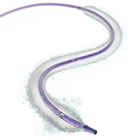|
Today's announcement follows the one-year results from the IN.PACT SFA Trial where the IN.PACT Admiral DCB resulted in highest rate of primary patency and the lowest rate of clinically-driven target lesion revascularization at 12 months in a pivotal study of interventional treatments for PAD. The two-year data presented today by John Laird, M.D., interventional cardiologist at U.C. Davis Medical Center, continues to show the IN.PACT Admiral DCB's superior safety and efficacy compared to standard balloon angioplasty, demonstrating sustained, longer-term clinical benefits.
"The IN.PACT Admiral DCB has produced consistently strong clinical results over the longer-term. At two years, the IN.PACT Admiral DCB showed strong patency and very low target lesion revascularization rates," said John Laird, M.D., interventional cardiologist at U.C. Davis Medical Center, co-principal investigator for the IN.PACT SFA Trial and first author of the published results in JACC. "These data results continue to validate this DCB as the durable, safe and primary treatment option, and are poised to impact the current SFA treatment paradigm." The IN.PACT SFA Trial enrolled 331 patients at 57 sites across Europe and the United States with a mean lesion length of 8.9 ± 4.96 cm. All study subjects were randomized to treatment with either the IN.PACT Admiral DCB or standard balloon angioplasty (percutaneous transluminal angioplasty, or PTA). Two-year outcomes revealed the following: The DCB group showed the lowest reported clinically-driven target lesion revascularization (CD-TLR) rate at two years, with 9.1 percent of patients requiring a repeat procedure, compared to 28.3 percent of patients in the PTA group (p<0.001). The data also showed a primary patency rate or restoration of blood flow through the treated artery of 78.9 percent in the DCB group, compared to 50.1 percent in the PTA group (p<0.001). Results are based on Kaplan-Meier survival estimates for primary patency at two years. The data continue to support an exceptional safety profile, with no major target limb amputations in either group (p>0.999) and low blood clot (thrombosis) rates of 1.5 percent in the DCB group, compared to 3.8 percent in the PTA group (p=0.243).
"As clinicians continue to seek the best treatment strategies for patients with peripheral artery disease, we investigated, and published findings in JACC, a DCB device that has produced consistent clinical results across all key subgroups and trials," said Michael R. Jaff, D.O., Paul and Phyllis Fireman Chair in Vascular Medicine at the Massachusetts General Hospital, medical director of VasCore, the Vascular Ultrasound Core Laboratory, professor of medicine at Harvard Medical School and senior author of the published results in JACC. "The consistency and durability of the DCB, combined with the benefit of not leaving a stent in the artery, make this a significant option for treating SFA disease." In a subgroup analysis from the IN.PACT SFA Trial, two-year results also showed clinical superiority and consistency across various patient types that have been proven difficult to treat based on historical data, including people with diabetes and the female population. For people with diabetes, the DCB group showed a higher restored blood flow rate of 73.3 percent, compared to 45.8 percent in the PTA group (p<0.001). In an evaluation of the female population, the DCB group showed a restored blood flow rate of 76.7 percent, versus 42.3 percent in the PTA group (p<0.001). "The IN.PACT Admiral DCB's cadence of strong clinical data not only demonstrates the therapy's sustained durability, but also our deep-rooted commitment to providing innovative technologies that advance healthcare together in partnership with clinicians worldwide," said Brian Verrier, vice president and general manager of the Peripheral franchise, within the Aortic and Peripheral Vascular business at Medtronic. "We look forward to unveiling additional new data on the device at VIVA." New two-year health economic data from the IN.PACT SFA Trial U.S. cohort and one-year data from the IN.PACT Global Study in-stent restenosis (ISR) cohort are forthcoming and will be presented at the Vascular Interventional Advances (VIVA) 2015 conference on Monday, November 2. In collaboration with leading clinicians, researchers and scientists worldwide, Medtronic offers the broadest range of innovative medical technology for the interventional and surgical treatment of cardiovascular disease and cardiac arrhythmias. The company strives to offer products and services that deliver clinical and economic value to healthcare consumers and providers around the world. About IN.PACT Admiral Drug-Coated Balloon IN.PACT Admiral DCB received the CE (Conformité Européene) mark in 2009 and approval by the U.S. Food & Drug Administration in December 2014. It is the most studied drug-coated balloon to date. Medtronic is conducting four Medtronic-sponsored studies which include IN.PACT SFA, IN.PACT Global, IN.PACT Japan and IN.PACT China to assess the safety and effectiveness of the IN.PACT Admiral DCB. In addition, Medtronic is supporting approximately 20 physician-initiated DCB studies. In total, data on more than 4,000 patients treated with the IN.PACT Admiral DCB will be available. About Medtronic Note: Dr. John Laird, MD is an advisor and paid consultant for Medtronic. Dr. Michael Jaff, DO is a non-compensated advisor to Medtronic. Any forward-looking statements are subject to risks and uncertainties such as those described in Medtronic's periodic reports on file with the Securities and Exchange Commission. Actual results may differ materially from anticipated results. Source: Medtronic plc |



